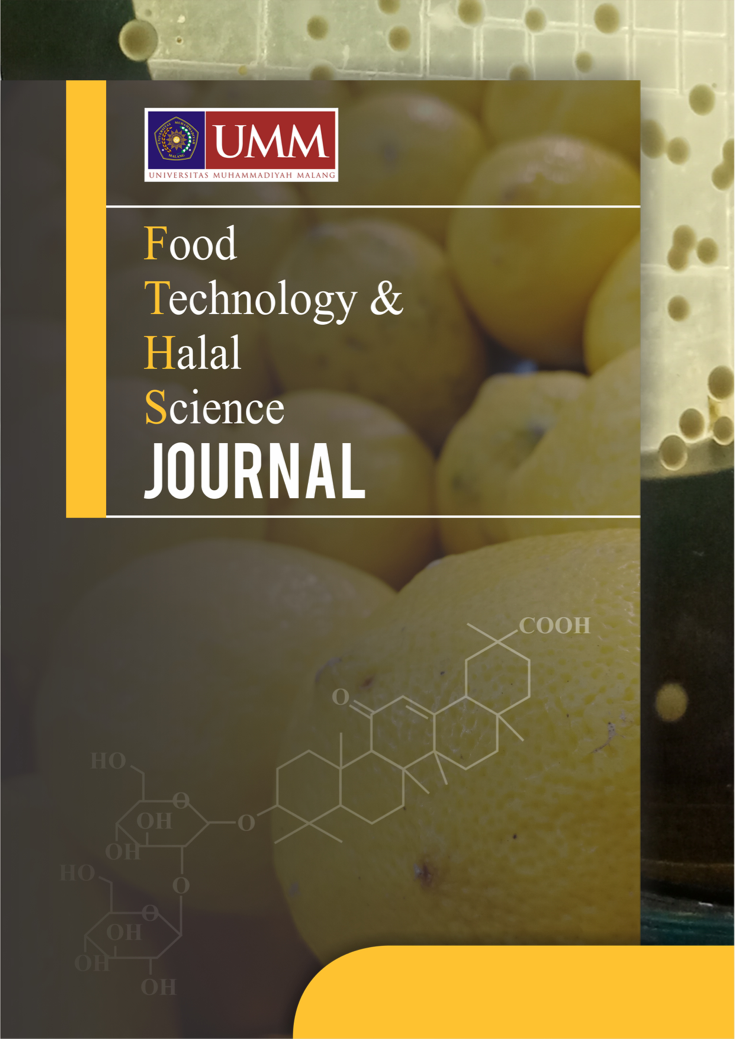Characterization of Edible Film from Starch of Taro (Colocasia esculenta (L.) Schott) with Addition of Chitosan on Dodol Substituted Seaweed (Eucheuma cottonii L.)
DOI:
https://doi.org/10.22219/fths.v1i1.7544Keywords:
Edible Film, Starch Talas, Chitosan, DodolAbstract
Abstract.Edible film is a thin layer to protect food which it can be consumed. One of the main components to make edible film is starch, which could be derived from taro tubers. Taro tubers contain high starch content about 70-80% which consists of 5.55% of amylose and 74.45% of amylopectin with yield reach to 28.7%. However, the weakness of starch-based edible film are low resistance to water and low barrier properties to water vapor. One of the recommended hydrophobic biopolymers to improve the film characteristics of starch as well having antimicrobial activity is chitosan. The objectives of this research are to know the interaction and influence of starch concentration from taro tuber and concentration of chitosan on physical and mechanical character of edible film, including thickness, density, transparency, tensile, elongation and water vapor transmission eate (WVTR). The best treatment from first objective will apply on dodol (food made by glutinous rice) substituted by seaweed to know the effect of its application on dodol shelf life (texture analysis, weight loss and microbiology). Therefore this research was conducted in 2 stages and 2 experimental design methods. The first stage was the process of making edible film using Randomized Block Design method and the second stage was the application of edible film using Random Design Complete method. The results of physical and mechanical analysis of edible film based on its effect on the storage of dodol showed that the best treatment was obtained of P3K3 treatment (6% of Taro starch: 3% of Chitosan), P3K1 (6% of Taro starch: 1% of Chitosan) and P3K2 (6% Taro starch: 2% of Chitosan). The application of 3 types of edible films based on the best treatment of dodol substitute of seaweed has significant effects on the value of weight loss, texture and total plate count during the storage period. Effectiveness of edible film in inhibiting damage to dodol was obtained of P3K3 treatment (6% of Taro starch: 3% of Chitosan) with WVTR value equal to 0.189 g / cm2 hour, 0.170 N / mm2 of tensile strength, 0.088% of elongation, 0.160 mm of thickness, 0.151 of density and 0.000 mm-1of transparency.Downloads
Download data is not yet available.
Downloads
Published
2019-01-13
How to Cite
Warkoyo, Y. W. N. H. (2019). Characterization of Edible Film from Starch of Taro (Colocasia esculenta (L.) Schott) with Addition of Chitosan on Dodol Substituted Seaweed (Eucheuma cottonii L.). Food Technology and Halal Science Journal, 1(1), 22–32. https://doi.org/10.22219/fths.v1i1.7544
Issue
Section
Articles
License
Authors who publish with this journal agree to the following terms:
- Authors retain copyright and grant the journal right of first publication with the work simultaneously licensed under a Creative Commons Attribution License that allows others to share the work with an acknowledgement of the work's authorship and initial publication in this journal.
- Authors are able to enter into separate, additional contractual arrangements for the non-exclusive distribution of the journal's published version of the work (e.g., post it to an institutional repository or publish it in a book), with an acknowledgement of its initial publication in this journal.
- Authors are permitted and encouraged to post their work online (e.g., in institutional repositories or on their website) prior to and during the submission process, as it can lead to productive exchanges, as well as earlier and greater citation of published work (See The Effect of Open Access).










